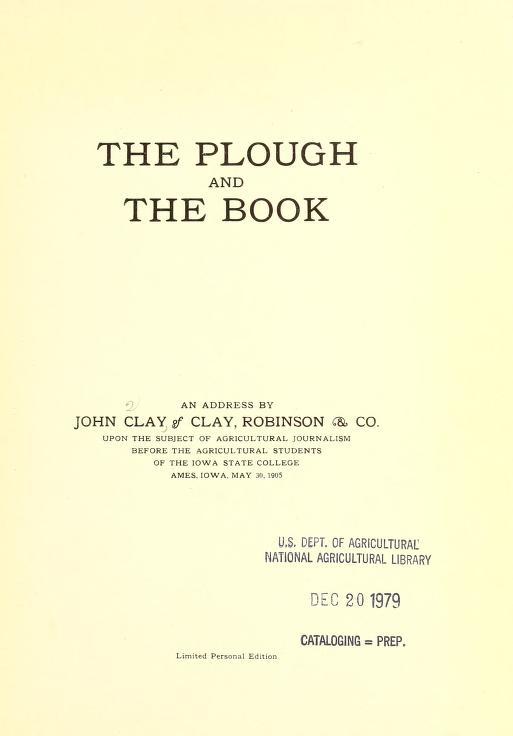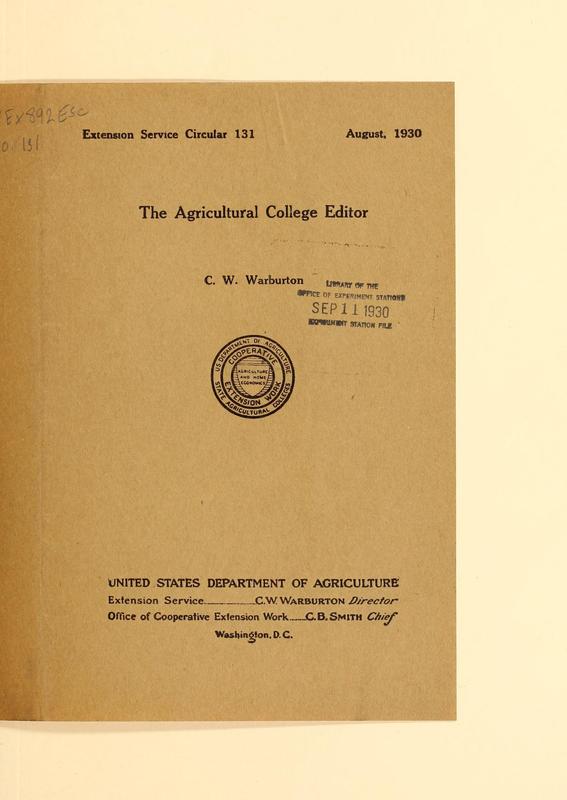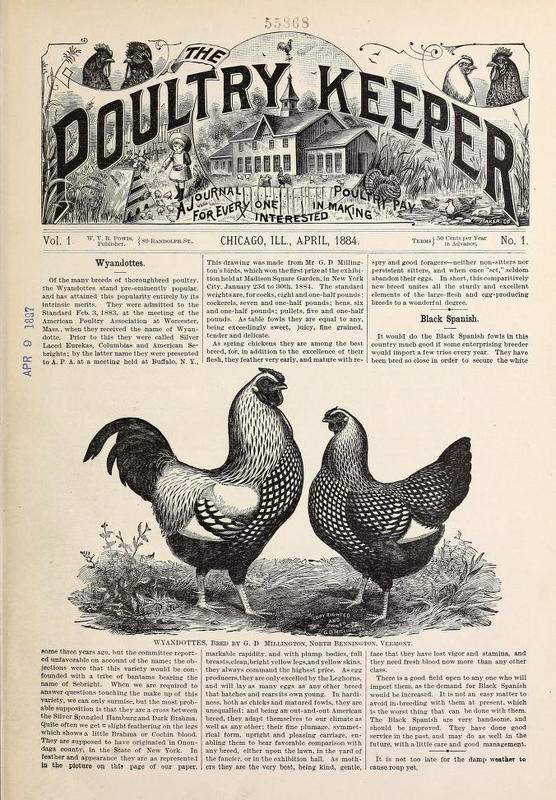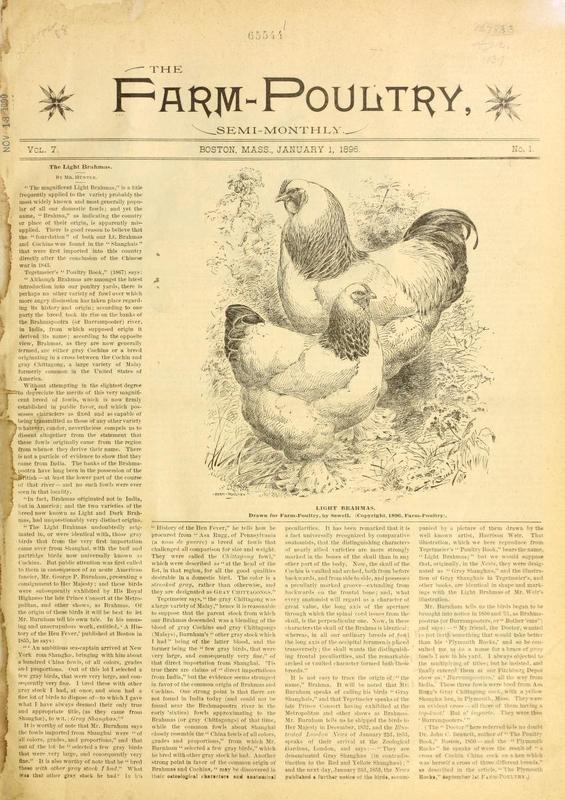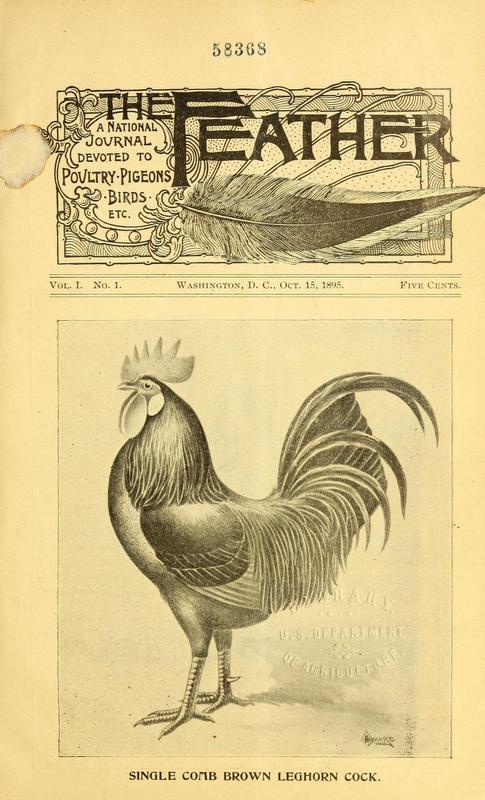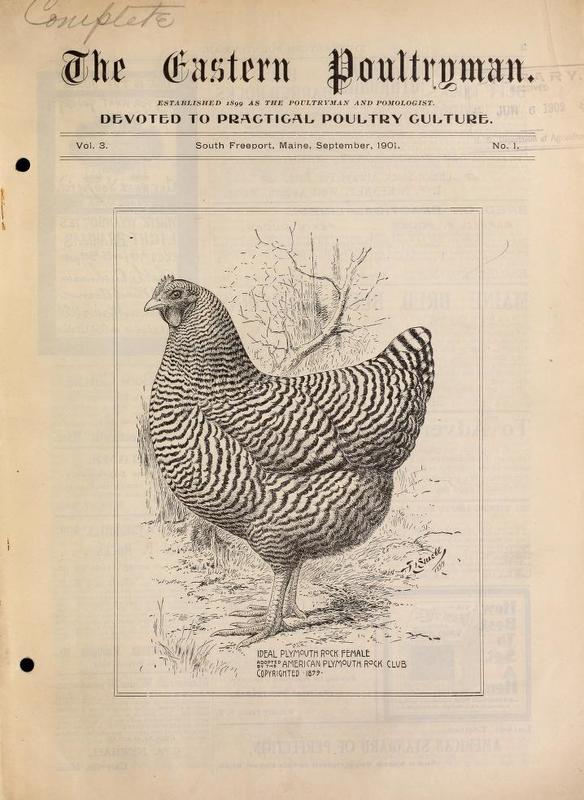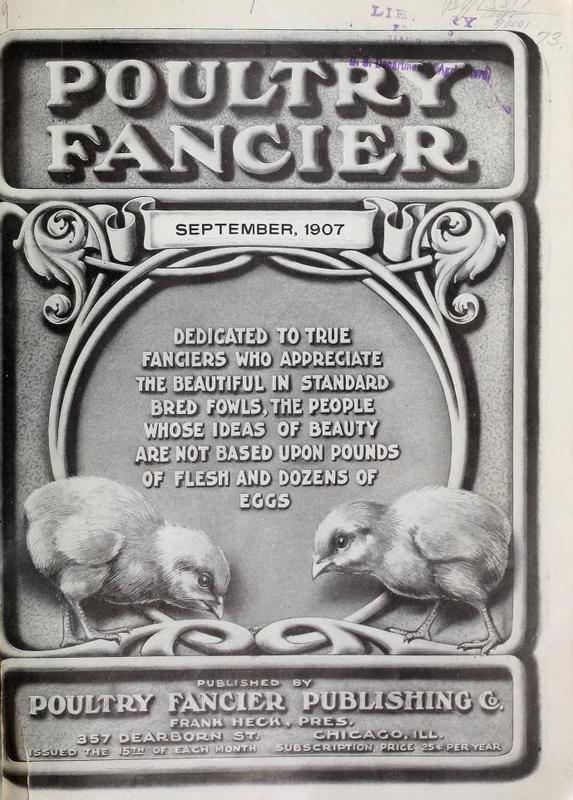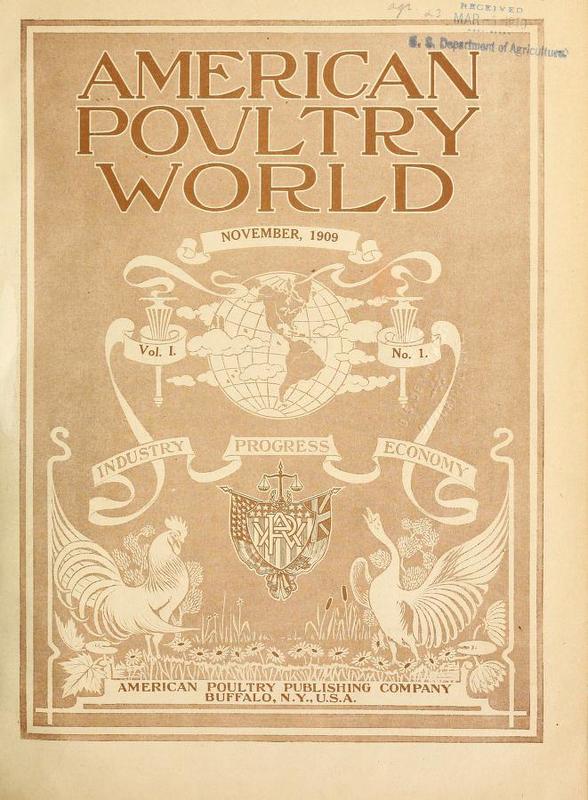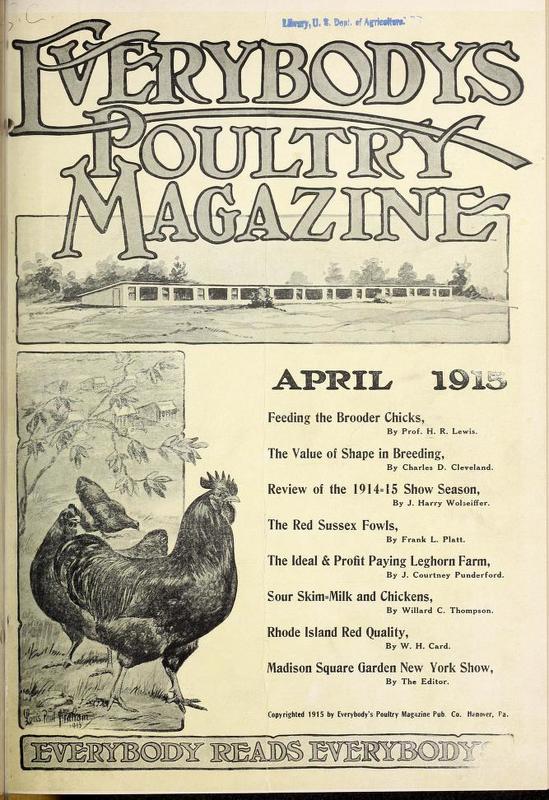Talking Hens
The rapid increase of agricultural journals [in the late 1800s] is an indication of the interest of the farmers in improved methods, for these papers were not only exponents, in advertisement and editorial, of better machinery, but they were practical and scientific teachers of better farming. The American Agriculturalist declared in 1869 the 'agricultural press was never half so well conducted or so influential as today'*
--Frank Mott (1938). A History of American Magazines, 1865-1885, Volume 3. Cambridge, MA: Belknap Press. page 151
*(The American Agriculturalist: For the Farm, Garden, and Household. Volume 28, Number 9, Series 272, September 1869, page 325)
This section will display some sample trade journals of the late nineteenth and early twentieth centuries that poultry farmers read for practical advice, news on current and future trends, and advertisements for equipment such as incubators, coops, and feeders.
It should be noted that the visual design of these publications changed over the years, reflecting competing desires to look first like newspapers, then like scholarly journals, and finally like modern magazines. Jessica Helfand's analysis, "Animal Magnetism"* analyzes the visual design of poultry magazines over 150 years (2008).
*Helfand, J. (2008, February 14). Animal Magnetism. Design Observer. Retrieved from http://designobserver.com/feature/animal-magnetism/6537
The following items include monographs about argricultural journalism and some representative issues of poultry serials owned and digitized by the National Agricultural Library
The Plough and The Book: An Address. An Address by John Clay of Clay, Robinson & Company Upon the Subject of Agricultural Journalism Before the Agricultural Students of the Iowa State College Ames, Iowa, May 30, 1905
John Clay
Ames, Iowa, May 30, 1905
"The coming work will be with the soil and how to get the best results from it, the improvement not only of our breeds of livestock, but of our grains and grasses, of our methods of feeding. Away in the distance we see a transformation scene in this vista just as we have seen it in our farm implements, or as we see it exemplified every day in our packing-houses. Compare the methods of the old slaughter house with those of the up-to-date packing plants of this hour. Those marvels of this age can be duplicated on the farm, but it will take study and science and patience to find the 'open sesame.' The Book will help more than the Plough."
The Agricultural College Editor
Warburton, Clyde William
U.S. Department of Agriculture. Office of Cooperative Extension Work, 1930
"Bulletins and newspapers have been prominently recognized for many years as means of supplying agricultural information. Only recently, however, have administrators realized that the preparation of information for popular use requires the services of a trained specialist - a specialist not only with a facility for explaining scientific facts in plain, readable, accurate language, but with breadth of view, an aptitude for organization, and a keen and accurate understanding of human nature. In the earlier days all too many thousands of printed pages that were for the most part unintelligible to the man whom they wore designed to influence were scattered over the countryside. Experiment station and college publications too often failed to present the results of research in clear, concise, practical terms. Scientists, although preeminent in their particular fields of research, were seldom expert publicists. What was needed was a person who could rescue the practical facts from obscuring and unfamiliar scientific terminology and impart them to farmers in language to which they were accustomed. The editor, as a connecting link between the man who knows and the man who wishes to know, supplied this need."
The Poultry Keeper
A Journal for Everyone Interested in Making Poultry Pay
Chicago, IL: W.V.R. Powis
Began with Volume 1, Number 1 (April, 1884)
OUR GREETING
"The Poultry Keeper makes a bow to its readers and greets them cordially. Though only recently arrived we have come to remain, and trust that the longer we stay the more highly we may be appreciated. We believe there is room for us, too, and that we can assist to bring in recruits and swell the array of veteran breeders. And in thus extending the hands of fellowship to all, we hope to be welcomed wherever we go, and have no fear of our reception on the part of all.
But our readers may wish to know something of us. The Poultry Keeper is published at 89 Randolph street, Chicago, and issued monthly, for 50 cents a year, the publisher being W. V. B. Powis, who also publishes the Farm, Field and Fireside, now having the largest circulation of any agricultural journal in the world. The editor is P. H. Jacobs, of Hammonton, N. J., who is a breeder of thirty years' experience, and whose writings on agricultural topics have been more extensively circulated and read than those of any other contributor in the country, the number of papers with which he has been connected as editor and contributor reaching the number of 600,000 copies every month. He will also be assisted by some of the most eminent poultry breeders known, and every effort will be made to make the new enterprise a complete success.
With this brief explanation of our journal we can only say that each month will find it more attractive than before, and as to whether or not it will succeed is not a pertinent inquiry, as it has already been placed upon a foundation too secure to admit of any doubt of its success."
The Farm-Poultry
A practical farm and suburban poultry raising guide
I.S. Johnson and Company
Volume 1, Number 1 (September, 1889) – Volume 27, Number 4 (April, 1916)
Later issues published by Farm-Poultry Publishing Company
"Several thousand new readers have recently become (or soon will become) acquainted with Farm-Poultry, and it is fitting that we should offer them a word of explanation as to the scope and purpose of this paper.
Farm-Poultry aims to be a practical, helpful poultry paper, the intention being to offer the advice and assistance of its editors and contributors to those who want to make their poultry profitable. 'Poultry for Profit,' is its motto, and is the only reason for its existence. If it fails in that one particular its failure is absolute.
The name of the paper expresses this meaning. It isn't 'Farm and Poultry,' as many seem to think — and that title would give us all the broad acres of the farm to roam over. We could talk of plowing, and planting, and cultivating, and harvesting, and farm machinery, and farm animals; but the " farm " is no part of our mission. The "poultry" part of the farm or suburban home is our business, and our readers of the past six years will attest that we stick pretty closely to our text.
Beyond everything else, we want to be helpful. The editors and contributors are practical and practicing poultry keepers ; are themselves studying the constantly arising problems of the business, and giving the fruits of their experience in these columns.
We want to ask particular attention to the questions and answers dejaartment, which is the most valuable department of the paper, and one of the strongest and best features ever introduced into a paper. It is an " experience meeting," and the special feature of printing both the readers' question and the editors' answer cannot be too highly commended. We want that all readers should feel free to ask questions. We will answer them to the best of our ability; but please remember that editors are human, and 'don't know it all' hence it is possible (just barely possible) that they may err in their judgment."
Farm-Poultry's constituency is a co-operative society, and we want your experiences and observations at the same time that you get ours; you can help us at the same time that we are trying to help you. Let us all work together in the making of Farm-Poultry better."
The Feather
A National Journal Devoted to Poultry, Pigeons, Birds, Etc.
The Feather Publishing Company
Began with Volume 1, Number 1 (Oct. 15, 1895)
"A National Journal Devoted to Poultry, Pigeons, Birds, Etc. We make our bow to the feather-loving public. The Feather is designed to meet the wants of those interested in the feathered tribes. It does not fill a long- felt want perhaps, but hope is expressed that it will at least prove a worthy adjunct to the many valuable publications of its kind now in circulation.
In character The Feather will be national, embracing thoughts and sentiments for all, irrespective of boundaries and locations. Its field is this broad land of ours, and the cultivation of the same will be its particular delight in the work it now begins. Its columns will be used for the enlightenment of its readers, not forgetting its duty towards those who contribute to its support and maintenance.
The brotherhood of man is expressive of our ideas of fraternity which should exist between the devotees of nature, and nothing would be more praiseworthy than the exemplification of brotherly love by the fanciers of poultry, pigeons, and birds of this glorious Republic.
The fancier is a lover of nature and the lessons of nature are harmonies of action. As fanciers of nature, we should look to the edification of ideas calculated to strengthen these thoughts by reason of affiliation with the things which unite us to the love and devotion of the natural."
The Eastern Poultryman
(Established 1899 as The Poultryman and Pomologist)
Devoted to practical poultry culture
George P. Goffin South Freeport, ME
"Devoted to practical poultry culture. Readers are invited to make any suggestions of changes or new features that would make the paper of greater value. The Eastern Poultryman is published in your interests and we want to hear from you.
The poultry business of to-day is one of the greatest of agricultural pursuits, and the utility side of poultry culture has become recognized by the fanciers of all varieties, and on the other hand, those who are breeding utility poultry find as much profit and more pleasure in having their stock approximate the standard requirements. The breeding and management of such stock is what the poultrymen of the East are aiming at, and a knowledge of which The Eastern Poultryman will endeavor to disseminate."
Poultry Fancier
Dedicated to true fanciers who appreciate the beautiful in standard bred fowls, the people whose ideas of beauty are not based upon pounds of flesh and dozens of eggs
Chicago, IL: Poultry Fancier Publishing Company
Volume 11, Number 1 (January, 1908)[Volume 20, Number 3 (1915)]
The first year of this publication carries Volume. 11, repeating the last Volume. numbering of its predecessor, Fancy Fowls
"We have no patience with the people who prejudicially maintain that 'a chicken is a chicken' or in other words take the stand that one "chicken' is as good as another. The ordinary mongrel fowl is in the same class with the razor backed hog, the scrub cow and the plug horse. They constitute the scum of the race. They will sometimes thrive under most adverse conditions, but so do weeds and other obnoxious things. They are good for no purpose but what Standard bred fowls would be infinitely better. There are people who ask what there is to admire in a chicken. These same people would treat with mingled pity and contempt the person who would ask them what there was to admire about a beautiful rose or other flower and yet the flower is to many people, much farther down the scale of beauty and value. A Standard bred fowl is not only beautiful to look upon but it is a living thing that ap- preciates proper care and responds to intelligent effort in fashioning it after our ideals. It is an interesting companion as much so as any dumb creature can be and to the true fancier there is a fascination in studying individual specimens and solving the problems of breeding, that is not equalled by the pleasure derived from an association with inanimate objects of any character. Maximum egg production and market poultry are secondary considerations from the view point of the fancier but the utility poultryman who is so prone to condemn the fancy must humiliatingiy admit that Standard bred or fancy fowls are the best layers, the best table fowls and are the foundation of every market poultry plant that accomplishes results worth mentioning."
American Poultry World
Curtis, Grant M.. American Poultry Publishing Company
Began with Volume 1, Number. 1 (Nov. 1909) and ceased with Volume. 8, Number. 11 (December, 1917)
"Devoted to the Upbuilding of the Poultry Industry in all its Branches. Whatever AMERICAN POULTRY WORLD can do, in its field of effort, to advance the common interests of the poultrymen and poultry organizations of Canada and of the United States will be done willingly, cheerfully — with loyalty to the welfare of the American Poultry Association as the representative body of poultry breeders and poultry workers in both countries."
Everybody's Poultry Magazine
Everybody’s Poultry Magazine Publication Company
"Everybody reads Everybodys" A National Poultry Publication Devoted to the Best Interests of Poultry and Its Breeders
Began with Volume 20, Number 4 (Apr. 1915) and ceased with Volume 73, Number 1 (Jan. 1968)
 An official website of the United States government.
An official website of the United States government.


